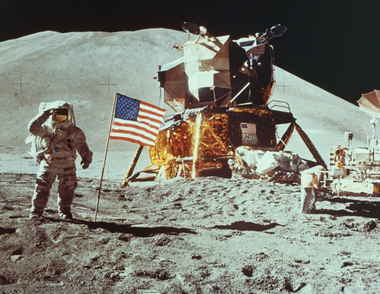
 THEY SAY: “Why spend money on NASA or space exploration when there is so much need here?”
THEY SAY: “Why spend money on NASA or space exploration when there is so much need here?”
WE SAY: “4.5 times more is spent on Food Stamps & 59 times more is spent providing other goods & services to the needy compared to the entire NASA agency budget.” Twice as much is spent on non-military foreign aid as NASA.
For those of you who still need an answer, we say go ask anybody from other countries around the world, “When was America greatest; when it landed on the moon in 1969 or when it spent $1 Trillion on its needy just in 2014?” The entire Apollo moon program cost $109 Billion (in today’s money) spread out over 10 years.
While the American moon program is a source of great pride to those still in the space program, it is absolutely embarrassing that our astronauts must hitch rides into orbit from our former moon program rival. It seems incredulous that a space program that was championed by two democratic presidents in the ‘60’s has fallen to its lowest point by a democratic president 40 years later. We are not advocating another government-ran moon program because Congress, NASA, and its contractors have gotten very smart at delaying the program with cost over-runs until $billions are wasted. Instead, we wish to commercialize space by a method of establishing guarantee aerospace markets and utilizing competitive, firm, fixed contracts that we refer to as “Space Billets”.
rides into orbit from our former moon program rival. It seems incredulous that a space program that was championed by two democratic presidents in the ‘60’s has fallen to its lowest point by a democratic president 40 years later. We are not advocating another government-ran moon program because Congress, NASA, and its contractors have gotten very smart at delaying the program with cost over-runs until $billions are wasted. Instead, we wish to commercialize space by a method of establishing guarantee aerospace markets and utilizing competitive, firm, fixed contracts that we refer to as “Space Billets”.
In the past,
- NASA determined by which method a mission was accomplished
- NASA designed the launch vehicles, NASA built the manufacturing, development, and launch facilities,
- NASA performed all the development work on new technologies, and
- NASA provided Cost-Plus contracts to contractors to provide the labor to build and launch the rockets. The major aerospace contractors didn’t have any “skin in the game” other than to provide labor and collect up to 9% profit on every dollar they convinced NASA to spend
Rather than cut or eliminate the space program, or punish NASA by cutting its funding, we need to change how NASA works.
WE SAY: Congress and NASA should set bold goals with long-term, guaranteed markets and let aerospace companies determine how to accomplish those goals.
Congress and NASA should set bold goals, such as sending 200 astronauts to the moon over the next 10 years and sending hundreds of astronauts and space tourists to several space hotels for 500 to 2,500 man-weeks per year, and let private enterprise determine how to accomplish those goals.
WE SAY: Congress and NASA shouldn’t be in the business of designing and developing rockets; they should only be involved with determining where we are going to explore, how many missions or people are going, and what are we going to do once we get there.
What are Space Billets and Why are They so Special? We advocate the use of Space Billets instead of Cost-Plus Contracts. Space Billets are firm, fixed contracts that NASA should utilize in conjunction with establishing guaranteed flight rates.
- A Space Billet is a firm, fixed pay-upon-completion contract that will replace the current cost plus fixed fee contract instrument that NASA usually utilizes.
- The Basic Space Billet is 10 tons of payload at $1,000 per lb (or 3 astronauts) transported from ground to Low Earth Orbit – a Basic Space Billet is worth $20 million.
- The Space Billet plan guarantees a market rate over a long time so businesses can make a commercial business case and obtain investment funding.
- We propose a market rate of 150 to 350 Space Billets per year – $3B to $7B per year.
- Liquid Oxygen (LOX) will make up 70% of Space Billets for payloads transported beyond Low Earth Orbit, i.e., the moon or geostationary orbit.
- Space Billets takes the design and development of launch vehicles, lunar landers, and other equipment out of the hands of NASA and the politicians (because NASA simply sets a goal of delivering astronauts to the moon, not how to accomplish that goal) and places it in the hands of businesses, who are going to find the cheapest method of accomplishing those different tasks.
- Space Billets will allow ANY commercial American company to deliver goods and astronauts not only to low earth orbit, but to the moon and beyond.
- Space Billets doesn’t develop and spend nearly $3 Billion per year just to maintain an expensive space station just for a few astronauts, instead it guarantees that at least 52 visitors will spend 10 weeks at a commercial space hotel per year for the next 5 years if a commercial company wants to provide one or more to NASA’s specifications.
- Space Billets doesn’t develop a vehicle to land on the moon, but instead it guarantees a market to transport at least 20 visitors to the moon’s surface (and back!) over 5 missions per year for 5 years if a commercial company wants to provide those services.
- Space Billets doesn’t develop a rocket to put things into orbit, but instead it provides a guaranteed market of 150 to 350 missions per year for 5 years at a fixed, low price that can be used by the government or purchased by private companies.
We think there is a major opportunity for America to retake the lead in space and turn space into a viable commercial enterprise via the use of Space Billets. Within 10 years, we think it would be possible for people to travel to beyond the moon. Within 25 years, we think commercial space tourism and lunar mining operations will nearly make NASA obsolete for near earth operations and at the same time take the politics out of the space program. Here’s how it would work:
Over a 10 year period, $35.6B (1,780 Space Billets) would accomplish the following:
- $ 4,300M: Remove ALL (~2,150) large space debris from orbit 1 mission/day for 8.6 years
- $ 4,870M: 730 astronauts and Gov. tourists transferred to LEO $10,400M: House 520 Astronauts and Gov. tourists in a space hotel for 10 weeks each
- $ 5,600M: Transfer 210 astronauts from LEO & Land on the moon
- $10,400M: House 210 astronauts & govt. tourists in Lunar Hotel for 10 weeks each.
- $82.86M per astronaut on the moon for 10 weeks
If so desired, a further investment of $18.5B would transport an additional 2,770 astronauts to LEO for a total of 3,500 visitors to LEO over 10 years. (Original Space Shuttle Concept: 7 astronauts x 50 missions/year x 10 years). A total investment of $54.1B over 10 years.
In like manner, a further investment of $5B per year for 10 years in Space Billets could be utilized to:
- $50,880M: House 210 astronauts in floating space stations on Venus
- $242.3M per astronaut at Venus
Other than the probes and astronauts, NASA doesn’t provide anything, the commercial companies perform all of the hardware development, vehicle processing, and launch operations.
We think that enough people will be interested in going to a space hotel that research conducted by NASA will play a minor role in the operation of the hotel; why send a NASA astronaut to conduct an experiment in space for you when you can go yourself. We think the American public will demand a much greater increase in funding the space program after we have established a space hotel and space tourists have a chance of landing on the moon or even Mars.
Dr. Neil deGrasse Tyson, as you can see we have not stopped dreaming about the future; we have merely put our dreams on hold until we can be given the opportunity to live them. In 2008, Candidate Obama stated that he would take money appropriated to NASA and give it to education[i]; unfortunately, too many people in the space community didn’t believe him.
DOWNLOAD OUR RECENT PRESENTATION HERE ON SPACE BILLETS
DOWNLOAD THE BOOK FOR FREE ON THE HOME PAGE TO FIND OUT MORE!
Several members of theUSAParty.com have been involved in the US Space Program for many years. We invite you to visit the website of our companion organization that is chartered by NASA: The Space Propulsion Synergy Team